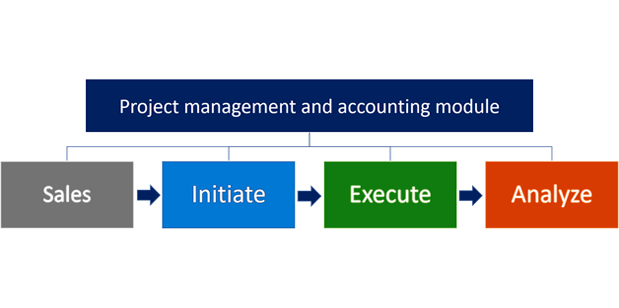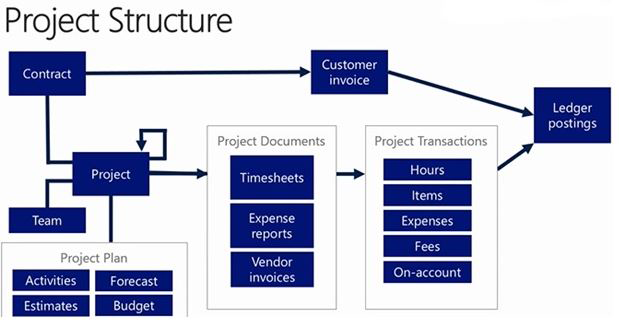Describe the project life cycle
Project management and accounting can be divided into four phases:
Sales
Initiate
Execute
Analyze
These phases are illustrated in the following process flow. The phases are aimed toward external projects, or projects that are completed for one or more customers. The internal and cost-only projects can also be divided into these four phases.

Sales
In the initial sales phase of a project, a project quotation lets you provide a customer with a nonbinding offer. A quotation can include elements such as the items and services that are quoted, basic contact information, special trade agreements and discounts, and possible taxes and surcharges.
Initiate
During the initiation phase of the project, it's assumed that the sales cycle is complete and the customer has accepted the contract. You can use a project quotation to communicate the estimated labor, expenses, and materials to the customer. You can record the billing terms, limits, and agreements in a project contract. You can use a work breakdown structure (WBS) to plan and estimate the work. You can set up forecasts and budgets to guide the project execution.
When initiating a project, you can:
Create project contracts that you can use to invoice customers.
Create work breakdown structures (WBS) to track work progress and cost.
Create project forecasts and budgets.
Create projects that are based on your needs.
Assign workers, categories, and resources to projects based on skill and/or availability.
The following illustration depicts the structure of a project, including the relationships between:
- the project.
- team members.
- planning.
- documentation.
- cost and revenue transactions.
- financial posting.

Execute
During project execution, team members or managers record work and the expenses that are incurred by using timesheets, expense reports, and other business documents. Project managers use tools to monitor the consumption of budgeted amounts for the project. Project managers can also order, pick, or procure materials for projects by using purchase orders and other business documents. Invoices are prepared and approved, so that customers can be billed for ongoing work. Finally, revenue is recognized during this process to affect the organization's financials.
Analyze
At its most basic level, a project is used to group transactions that record costs and then post these costs to the general ledger.
Generally, these transactions are the result of business documents, such as timesheets, expense reports, vendor invoices, or inventory transactions. The life cycle of a project usually starts with estimates, forecasts, and budgets that help plan and anticipate the work and financial results of the project. As you analyze a project, you can evaluate not only the transactions that occurred during the project, but also the accuracy of your estimates and forecasts, the utilization rates of the project team members, and the overall success of the project.
The remainder of this module focuses on the sales and initiate phases. The execute and analyze phases will be covered in the next module.